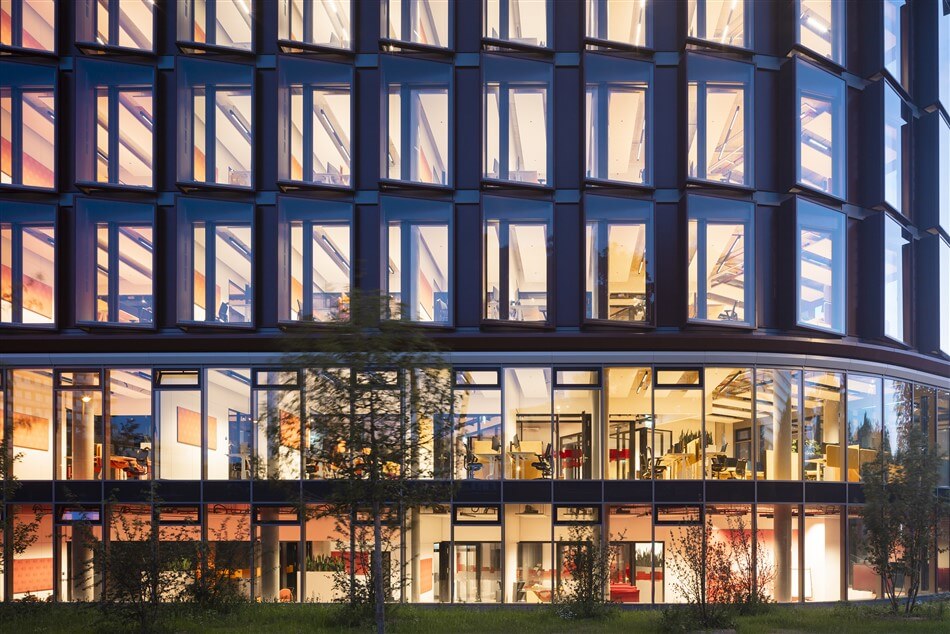
Eclipse Dusseldorf By Unstudio/HPP
Location: Dusseldorf, Germany
Status: Completed, 2023
Designed for die developers, Eclipse is a new vertical work campus located on Kennedydamm in Dusseldorf and home to the auditing and consulting firm PwC Germany. The highly sustainable campus was designed in a collaboration between UNStudio and German architecture firm HPP Architects and was realised by HPP Architects.

The main goal of the design for the campus is to foster interaction and inspire creativity by providing an inspirational and attractive work environment for today’s talent. The 60-metre high building offers approx. 27,000 m2 of light-flooded, contemporary office space with approx. 1,200 workplaces. In addition, the interior, which spans 16 storeys, houses inspiring communication and experience areas, while lively atria form the communicative backbone of the building. The overall vision for this vertical campus is one of transparency and an open gesture towards the surrounding neighbourhood. The tower follows the shape of the site with a triangular floorplan and stands on a two-storey podium, while two basement levels provide the service entrance, delivery, parking for 455 vehicles and a 200-space bicycle storage.

With its 360-degree facade, Eclipse is thoughtfully integrated with the existing site: the northern-facing facades are placed parallel to Kennedydamm in order to align with the main route to the centre of Düsseldorf, while the southern face is aligned with the neighbouring Hilton Hotel. The podium building, with its accessible rooftop garden, is directly connected with the lower section of this neighbouring building. Both the Eclipse Tower and the Hilton Hotel frame the rooftop garden and the main entrance to Eclipse. This entrance is further accentuated with a diagonally framed setback that is accentuated by contrasting opaque and transparent portions of the facade. To emphasise the main entrance and to distinguish the volumes of the podium and the tower, the tip of the tower cantilevers is approximately 11m above the driveway. The seemingly floating tower volume is supported by a three-dimensional V-shaped column. Entering the building is a smooth transition from outside to an inviting interior lobby, meeting facilities and a restaurant area. Here, a centrally located skylight provides generous daylight and allows for vertical views of the southern part of the tower facade. The principle of the main entrance is repeated on the southern facade, in order to connect the lobby with the outdoor conference terrace on the other side of the podium.

The backbone of the vertical campus, in terms of its spatial organisation and physical connection of programmes, is a three-dimensional helix. A series of interior atrium spaces spiral upwards along the facade of the building. This connects various office programmes and culminates in a panoramic roof garden, which can be used for social events. In contrast to the regular grid of typical facades, the helix structure and its effect of clustering programmes vertically is made visible from the outside. Large-scale and plain facade portions pronounce the volumes of the atria programmes to the outside. As such, a higher degree of transparency in the facades renders the position, scale and activity level of the programmes behind readable from the outside, while from inside out, the atrium facades frame scenic views of the surrounding city.
In the organisation of the individual floor plans, the atrium spaces form important destinations for special programmes, connections and orientations. In addition to the provision of individual workspaces throughout, the atria hosts collaborative, informal working spaces and breakout areas for encounters, meetings and coffee breaks. The individual offices have excellent daylight access and are highly flexible. They are designed to allow for adaptation into landscape-office, cell-office or a mix thereof. Here, focussed, specialised, undisrupted, and eventually confidential work routines are supported. As a complementary strategy, the atrium spaces introduce the idea of a vertical campus of connection, collaboration and communication. The intention here is to combine the rationality of office efficiency with a social surplus, making the work environment social, meaningful and healthy for all employees.

In addition to the passive sustainable measures undertaken in the design, Eclipse will be equipped with ‘smart engine‘ technology. The technology is controlled by sensors that manage a variety of functions. Daylight, artificial light and room ventilation are all controlled by individual human presence. This is made possible by 2,000 sensors that collect data in real-time and transmit it to the ©smartengine. As a result, up to 200 tonnes of CO2 savings per year can be achieved in a building of this size, which makes Eclipse a particularly sustainable office building. With over 200 parking spaces for bicycles and charging stations for e-cars, the building also contributes to the urban mobility of the future. The interior spaces alternate between concentrated work in cellular offices, while recreation zones function as meeting places. The layouts are flexible and reversible and as such can respond to future requirements. For Eclipse, not only a DGNB Platinum certification is planned, but also DGNB Diamond: the highest recognition for design and building culture quality.
more. www.unstudio.com

